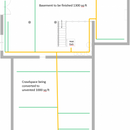Should HVAC calcs be run on existing home during basement finishing?
Good morning GBA Community,
I’m finishing my basement and converting the crawlspace from vented to unvented. I am curious about whether as part of the project I should have whole house Manual J, S, and D calculations run to inform the HVAC design. I have read here that most HVAC subs will opt to use a rule of thumb on sizing for ducts and the system overall which leads to less than optimum system sizing and duct placement (particularly on return).
The house is 1977 construction in northern Virginia (CZ 4), single level, 2300 finished sqft in the main level with 1300 sq ft about to be finished in the basement and approximately 1000 sq ft crawlspace. The heat pump indoor unit is centrally located with a straight shot trunk line running through the crawl space with runs off to room-edge registers on the main level. The runs are insulated, but the trunk isn’t. There is no discernible sealing on the trunk. I haven’t pulled back the insulation on the runs to see if there is any sealing there. The lines in the basement portion have more bends to get them around to the upstairs registers, which are mostly at room edges. All of the runs in the basement portion are insulated so I haven’t been able to see if there is any sealing done (mastic or tape), but I’m betting not. One central return sits almost directly above the main unit and drops down straight. There are return pressure issues (it’s kind of charming, when the heat turns on, our bedroom door shuts on its own! — I’m going to fix this with in-door return air pathways from Tamarack).
Here’s my plan, subject to your criticisms:
1. Purchase either through HVAC sub or independent entity, a set of whole-house Manual J, S, and D calculations and optimal design for new supply and return runs for basement space being finished and new supply to crawlspace, as well as recommending any changes to existing ducts supplying finished area of house.
2. Seal the crawlspace trunk as best I can with RCD #6 mastic, thick as a nickel and fiberglass mesh tape where needed.
3. Specify for the new basement ducting, HVAC sub use rigid ducting to the maximum extent possible, with joints screwed and joints and seams sealed with mastic thick as a nickel, all supply insulated to R-8.
4. Have HVAC sub or another party perform duct blaster testing, then aeroseal, then duct blaster testing to address leaks in the existing system that I can’t get to with mastic.
I am concerned about whether the HVAC sub can / will run the Manual J/S/D calculations for design — should I search for an independent firm to do this? As a note, I am working through a GC, so he has relationships with a set of HVAC subs that he typically uses and I don’t know whether they are experienced with performing the calculations prior to design.
Fire away! And thank you for your thoughts.
Eric S
GBA Detail Library
A collection of one thousand construction details organized by climate and house part










Replies
A properly finished basement add very little heating and almost no cooling load (does a bit of latent cooling, sometimes a dehumidifer is still needed).
If your furnace has been supplying your upstairs well, there is really no need to go nuts and re-pipe the setup. Sometimes it makes sense to move the main trunk for ceiling height but doesn't look like the case for you.
You do need to add properly sized supply and return registers to your basement and crawlspace.
Insulating and air sealing ductwork is important when it is outside the conditioned envelope (in attics or vented crawlspace).
With the ducting now being inside conditioned space, insulation on the ductwork doesn't matter. Any losses there are stayl inside the thermal envelope so they don't get lost. Air sealing the return is still a good thing. With proper filter grills and well sealed return, your ductwork will stay sparkling clean.
Air sealing the supply doesn't hurt but don't need to go overboard.
Yes but also no. It doesn't sound like you are changing equipment or running all new ductwork, so a design in the traditional sense isn't really what you need. Source: I'm an hvac system designer.
What I do in renovation to existing duct systems is: Start by visiting the site and measuring the existing system. System static pressure, airflow from all the registers, total airflow, delivered air temperatures, duct sizes, etc. I also collect information for a heat gain/loss calc. I talk to the customer to try and determine any existing comfort issues, like cold/hot rooms or slamming doors, how long the system seems to run during hot/cold times. This tells you how a system is actually performing, which is the most important thing for an existing system.
You do the heat loss/gain calc to ensure the equipment has enough capacity (10/10 so far it is way oversized) and then you give them a list of things to improve the system, like adding additional registers to uncomfortable rooms and fixing return issues, upsizing any ducts that are too small, repair any damage ducts you might have observed, airsealing existing ducts, maybe insulating long lines, balancing ductwork, etc. If you bring a good hvac tech along, he can check out the equipment and tell you if now is a good time to change it out or if it still has lots of life left. That's the process that should be taken. Measuring the existing system performance is key to a good retrofit design.
Thank you Akos & Yupster. I appreciate your thoughts. I will make sure they measure the current system performance and ensure they plan in supply and return that makes sense for the new parts in the basement.
Eric